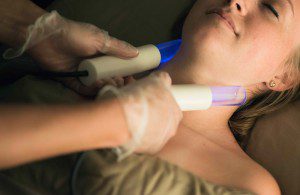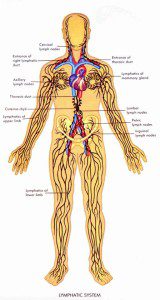K6 Wellness Center offers 2 lymphatic therapy options. Keep reading to learn about lymphatic therapy in general then choose each link to see the differences in each option.
Lymphatic Therapy with the LYMPHSTAR
Lymphatic Therapy with FLOWpresso
What is lymphatic therapy?
Lymphatic therapy targets the lymphatic system which is the secondary system of circulation in the body with a very complex set of tasks. The major tasks are cleaning and nourishing the cells. Sounds simple enough, but without it, we wouldn’t survive long. The lymphatic system is a sort of go-between from the blood circulation to the individual cells. Lymph is a clear fluid containing nutrients and oxygen similar to blood but without the red and white corpuscles. It comes from the general circulation and is deposited around the cells to keep them nourished. The cells are able to discard waste and toxic materials into this fluid. The lymphatic vessels pick up this waste and any excess fluid from around cells and transport it, via the lymph nodes which filter it, back into the general circulation. It’s a one-way shuttle, so lymph should only ever flow in one direction – away from the cells and towards the heart.
 Common Causes of Poor Lymphatic Drainage
Common Causes of Poor Lymphatic Drainage
- Poor lifestyle choices are the most common causes of an inefficient lymphatic system, though they are certainly not the only ones.
- Lack of exercise – lymphatic fluid needs muscle power to push it round the body
- Poor diet – may increase congestion and produce more waste for the lymph to pick up and dispose of
- Pollutants – environmental and dietary
- Surgery and trauma
- Pregnancy
Benefits of Lymphatic Therapy
Every part of the body is influenced by the lymphatic system, because no matter what the purpose of the cells, they all need nourishing and cleaning.
It’s important in immunity, inflammation and healing in general, so an efficient lymphatic system is going to help in many areas. Lymphatic drainage is a way to achieve that efficiency.
- Skin care: For a clearer complexion and to lessen the appearance of fine lines and wrinkles in facial tissue, as well as reducing puffiness around the eyes. Old scar tissue can be reduced while the appearance of new scars can be minimized. It’s commonly used before and after cosmetic surgery.
- Detox: At the end of winter, or after a period of high stress, the body will really benefit from lymphatic drainage, to reduce the sluggishness brought on by too many starchy, high fat foods and too little exercise.
- Headache: Most headaches, including sinusitis, have a component of congestion that responds well to lymphatic drainage. Once tissue is decongested, blocked fluid and blood flow improve, reducing pain and discomfort.
- Promote healing: After surgery or injury, the tissue may be swollen and sore. Lymphatic drainage is a gentle treatment that will help drain the tissue, reduce inflammation and improve healing.
- Pregnancy and after: There is often fluid retention in pregnant women and lymphatic drainage can improve comfort especially in legs and feet. Breastfeeding will be enhanced by this treatment, especially when there are problems with blocked ducts and sore tight breasts.
- Reduce swelling: After long periods of immobility such as air travel or lessened mobility, fluid tends to stagnate in the tissue making it puffy and tender.
Conditions such as arthritis often have joints that are congested with fluid. All of these respond well when fluid is reduced with lymphatic drainage. - Relaxation: Because it is such a gentle treatment, it is one of the most relaxing. And the relaxation is enhanced as the cleansing and rejuvenating effects relieve stress.
Most people will notice improvements in their level of well-being after a treatment because lymphatic drainage has so many benefits. Keep yourself looking and feeling in tip-top condition with a regular session.
Read more: http://www.naturaltherapypages.com.au/article/benefits_of_lymphatic_drainage#ixzz3BGwSdN9E
***Contraindications: There are 3 suggested contraindications given: blood clots, implanted medical devices with electronic circuits, and neoplastic conditions.***


